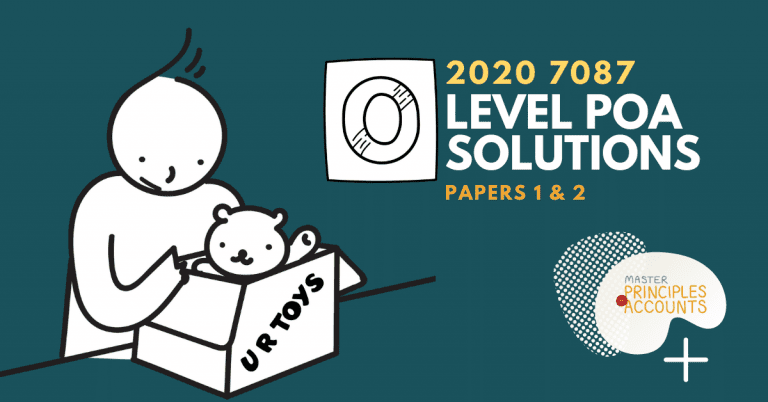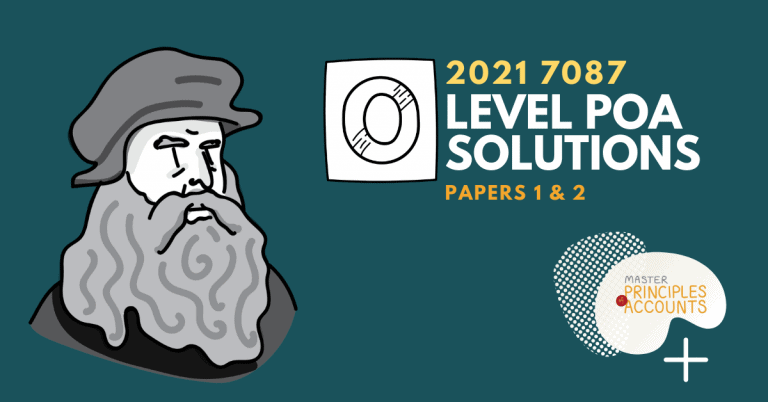2018 O Level POA Answers Paper 1
(a) Materiality concept. Expenditures that should be capitalised as the cost of the non
current assets can be treated as expenses if the value of the item is insignificant (immaterial)
(b) General Journal
(c) Owner purchased equipment from overseas and needs to train staff to operate it. Identify
if the following costs is capital or revenue expenditure:
| Capital expenditure | Revenue expenditure | |
| Installation costs | ✔ | |
| Staff training | ✔ | |
| Import duties | ✔ |
(d)
Statement to show corrected profit for year ended 31 August 2018
| $ | $ | |
| Profit before adjustment | 240000 | |
| i) Less: repairs for existing warehouse* | (5,000) | |
| ii) Add: Legal fees related to gaining building permission | 1,250 | |
| Adjusted profit | 236,250 |
(e)
1. Decision-making.
2. Stewardship
(a) Total sales = Cash sales credit sales
Cash sales = $4,800 + ($1,000 X 12 months)= $16,800
Credit sales = $27,000 + $87,800 $22,000 = $92,800
Total sales = $16,800 + $92,800 = $109,600
(bi) If gross profit margin = 40%
and Net sales revenue – cost of sales = Gross profit,
NSR – COS = GP
100% – 60% = 40%
Cost of sales = $109,600 x 60% =$65,760
Expected inventory at 30 June 2018 = ($4,300 + $67,100 $980) $65,760 = $4,660
(bii) Value of inventory destroyed = Expected inventory actual inventory = $4,660 $2600
(c) Going concern concept
(ai) Examples of income of SERVICE business
Any one of the following:
-Advertising income
-Consultancy income
-Tuition fee income
-Hair salon services
(aii) Examples of expenses of a SERVICE business
Any two of the following:
-Rent expense
-Advertising expense
-Wages expense
-Depreciation expense\
(b)
Formula for expense to(Expenses/Net Sales Revenue) X 100%
| 2016 | 2017 | 2018 | |
| Workings | Expenses= $582,000 $361,000= $221,000 % expenses to NSR$(221,000/582,000) x100%= 37.97% | Expenses= $685,000 $452,000$233,000 % expenses to NSR=$(233,000/685,000) x100%34.01% | Expenses$655,000 $413,00$242,000 % expenses to NSR$(242,000/655,000) x100%: 36.94% |
| Expenses to netsales revenue % | 37.97% | 34.01% | 36.94% |
(c)
-Changes in profitability over 3 years (+ evidence from question)**
Sales revenue has increased steadily from $582,000 in 2016 to $685,000 in 2017 to $655,000 in 2018.
-In absolute terms, the business’ profits have fluctuated from 2016 to 2018. Business profits has increased from $361,000 in 2016 to $452,000 in 2017 and decreased to $413,000 in 2018.
-Although the number of bus tours has decreased from 650 in 2016 to 600 in 2017, the profit has increased this suggests that the business was more efficient in managing its resources. The percentage of expense to turnover supports this observation. The percentage of expenses has fallen steadily from 37.97% in 2016 to 34.01% in 2017.
-This suggests that the tour company was able to book more revenue per bus which could mean they were either able to charge higher price per seat (better brand name) or was able to pack more tourists in each bus tour. However, the percentage of expenses has worsen from 34.01% in 2017 to 36.94% in 2018. This suggests that they were less efficient in managing its resources. Possible reasons could be a rise in competition resulting in a price war or increased cost of operations such as a fuel hike or toll charges.
(d)
1. Sole proprietorship only has 1 owner while a limited company has a maximum of 50 shareholders.
2. In a sole proprietorship, the owner has total control over business operations while a shareholder in a limited company has minimum or no involvement in the business.
3. In s sole proprietorship, all profits are enjoyed by the owner while in a limited company, the profits made will be shared as dividends to shareholders.



